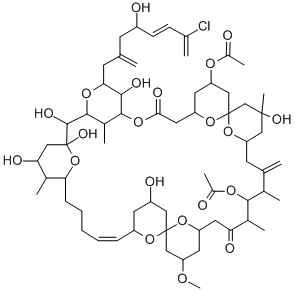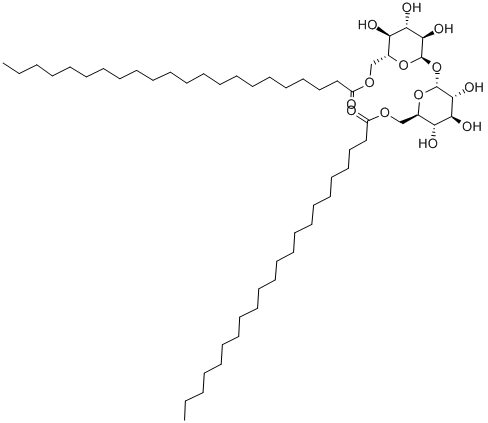MONOBEHENIN
- CAS NO.:30233-64-8
- Empirical Formula: C25H50O4
- Molecular Weight: 414.66
- MDL number: MFCD00273075
- EINECS: 250-097-0
- SAFETY DATA SHEET (SDS)
- Update Date: 2024-12-18 14:08:52

What is MONOBEHENIN?
Chemical properties
Glyceryl behenate occurs as a fine white-yellow powder, as a hard waxy mass or pellet, or as white or almost white unctuous flakes. It has a faint odor.
Production Methods
Glyceryl behenate is prepared by the esterification of glycerin by behenic acid (C22 fatty acid) without the use of catalysts. In the case of Compritol 888 ATO (Gattefosse′), raw materials used are of vegetable origin, and the esterified material is atomized by spraycooling.
Definition
ChEBI: 1-behenoylglycerol is a fatty acid ester resulting from the formal condensation of the hydroxy group at position-1 of glycerol with the carboxy group of docosanoic acid. It has a role as a plant metabolite and an antineoplastic agent. It is a 1-monoglyceride and a fatty acid ester. It is functionally related to a glycerol and a docosanoic acid.
Pharmaceutical Applications
Glyceryl behenate is used in cosmetics, foods, and oral pharmaceutical
formulations.
In pharmaceutical formulations, glyceryl behenate is mainly used
as a lubricant in the preparation of oral tablets and capsules. It
has good binding properties, it does not affect tablet hardness and is
unaffected by mixing or production parameters. Glyceryl behenate
has been investigated for the encapsulation of various drugs such as
retinoids. It has also been investigated for use in the preparation
of sustained-release tablets; as a matrix-forming agent for the
controlled release of water-soluble drugs; and it can also be used
as a hot-melt coating agent sprayed onto a powder or drug-loaded
sugar beads and granules. It may also be incorporated via
extrusion/spheronization into pellets, which can be further compressed
into tablets.
Glyceryl behenate is used in oral enteric-coated pellets, powders
and suspensions. It is also used in controlled, extended-release and
orally disintegrating tablets. For oral preparations, glyceryl
behenate forms a lipidic matrix for sustained-release formulations.
It has been used along with acid-soluble or swellable polymers to
mask the bitter or unpleasant taste of the medicament with
improved palatability.
Glyceryl behenate has been used for the preparation of
ophthalmic inserts.
In cosmetics, glyceryl behenate is used as a skin conditioning
agent, emollient and viscosity-increasing agent in emulsions. It also
improves the heat stability of emulsions and is a gelifying agent for
various oils. For topical formulations, it is used as a thickening
agent for oily phases. It is also used as a surfactant or emulsifying
agent.
Safety
Glyceryl behenate is used in cosmetics, foods and oral pharmaceutical
formulations, and is generally regarded as a relatively
nonirritant and nontoxic material. The US Cosmetic Ingredients
Review Expert Panel evaluated glyceryl behenate and concluded
that it is safe for use in cosmetic formulations in present practices of
use and concentration.
LD50 (mouse, oral): 5 g/kg
storage
Glyceryl behenate should be stored in a tightly closed container, at a temperature less than 35°C.
Regulatory Status
GRAS listed. Accepted for use as a food additive in Europe. Included in the FDA Inactive Ingredients Database (oral capsules, tablets, and suspensions). Included in the Canadian List of Acceptable Non-medicinal Ingredients.
Properties of MONOBEHENIN
| Density | 0.93[at 20℃] |
| vapor pressure | 0.001Pa at 25℃ |
| solubility | Soluble, when heated, in chloroform and dichloromethane
and in many organic solvents; slightly soluble in hot
ethanol (96%); practically insoluble in cold ethanol (95%),
hexane, mineral oil, and water. |
| form | A solid |
| color | White to off-white |
| Water Solubility | 100ng/L at 25℃ |
| EPA Substance Registry System | Docosanoic acid, monoester with 1,2,3-propanetriol (30233-64-8) |
Safety information for MONOBEHENIN
| Signal word | Warning |
| Pictogram(s) |
 Exclamation Mark Irritant GHS07 |
| GHS Hazard Statements |
H302:Acute toxicity,oral H315:Skin corrosion/irritation H319:Serious eye damage/eye irritation H335:Specific target organ toxicity, single exposure;Respiratory tract irritation |
| Precautionary Statement Codes |
P261:Avoid breathing dust/fume/gas/mist/vapours/spray. P305+P351+P338:IF IN EYES: Rinse cautiously with water for several minutes. Remove contact lenses, if present and easy to do. Continuerinsing. |
Computed Descriptors for MONOBEHENIN
New Products
(S)-3-Aminobutanenitrile hydrochloride 4-Methylphenylacetic acid N-Boc-D-alaninol N-BOC-D/L-ALANINOL Tert-butyl bis(2-chloroethyl)carbamate 3-Morpholino-1-(4-nitrophenyl)-5,6-dihydropyridin- 2(1H)-one Furan-2,5-Dicarboxylic Acid Tropic acid 1-Bromo-3,5-Di-Tert-Butylbenzene S-2-CHLORO PROPIONIC ACID ETHYL ISOCYANOACETATE 2-Bromo-1,3-Bis(Dimethylamino)Trimethinium Hexafluorophosphate 4-IODO BENZOIC ACID 3-NITRO-2-METHYL ANILINE 1-(2,4-DICHLOROPHENYL) ETHANAMINE (2-Hydroxyphenyl)acetonitrile 4-Bromopyrazole 2-(Cyanocyclohexyl)acetic acid 4-methoxy-3,5-dinitropyridine 1-(4-(aminomethyl)benzyl)urea hydrochloride 2-aminopropyl benzoate hydrochloride diethyl 2-(2-((tertbutoxycarbonyl)amino) ethyl)malonate tert-butyl 4- (ureidomethyl)benzylcarbamate Ethyl-2-chloro((4-methoxyphenyl)hydrazono)acetateRelated products of tetrahydrofuran








You may like
-
 2033-24-1 98%View Details
2033-24-1 98%View Details
2033-24-1 -
 42831-50-5 5-METHYLISOXAZOLE-4-CARBOXYLIC ACID 98%View Details
42831-50-5 5-METHYLISOXAZOLE-4-CARBOXYLIC ACID 98%View Details
42831-50-5 -
 1975-50-4 98%View Details
1975-50-4 98%View Details
1975-50-4 -
 2-HYDROXY BENZYL ALCOHOL 98%View Details
2-HYDROXY BENZYL ALCOHOL 98%View Details
90-01-7 -
 2-Chloro-1,3-Bis(Dimethylamino)Trimethinium Hexafluorophosphate 221615-75-4 98%View Details
2-Chloro-1,3-Bis(Dimethylamino)Trimethinium Hexafluorophosphate 221615-75-4 98%View Details
221615-75-4 -
 61397-56-6 CIS BROMO BENZOATE 98%View Details
61397-56-6 CIS BROMO BENZOATE 98%View Details
61397-56-6 -
 14714-50-2 (2-Hydroxyphenyl)acetonitrile 98+View Details
14714-50-2 (2-Hydroxyphenyl)acetonitrile 98+View Details
14714-50-2 -
 118753-70-1 98+View Details
118753-70-1 98+View Details
118753-70-1